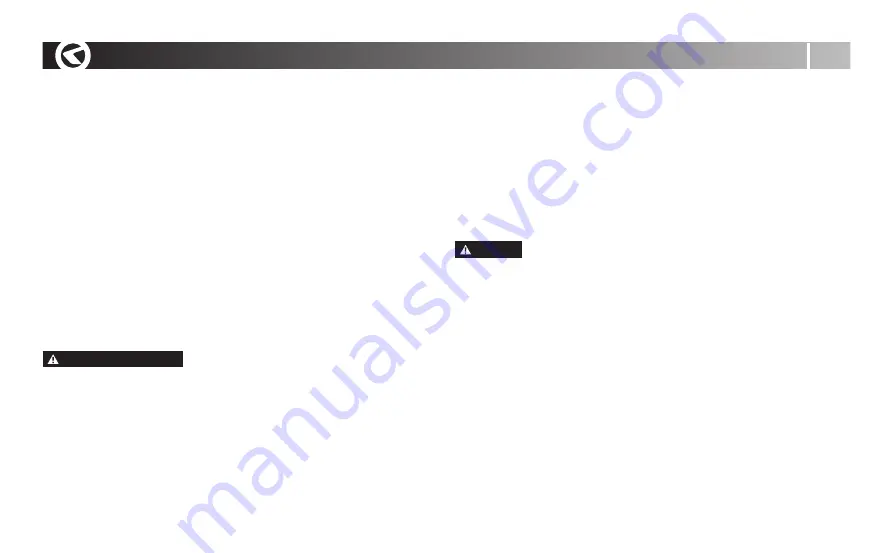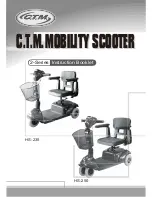
EN
OWNER'S
MANUAL
EBIKE
7
If necessary, use KLS mounting paste for carbon components. Observe the tightening torques of
the stem and handlebar bolts in case of over-tightening, there is a risk of damage to the frame and/
or clamp.
E-BIKE MAINTENANCE
In order for your e-bike to perform its function reliably, we would like to remind you that its use
requires maintenance. Regularly check that the nuts and bolts are sufficiently tightened.
Do not touch moving parts of the e-bike such as wheels, chains, brake discs, freewheel and
chainwheels, derailleur pulleys, cranks, tires, etc. when using, maintaining, and handling the
e-bike. Entrapment and subsequent injury may occur. Similarly, do not touch the coil springs of the
suspension or the brake calipers, as there is a risk of bruising, cutting or other injuries. When using,
maintaining, and otherwise handling the e-bike, consider the specific risk of entrapment and use the
e-bike with this risk in mind.
CRANKS AND PEDALS
Tighten the cranks after the first 20 km or so, also tighten the pedals to the cranks. Check that the
chainwheel bolts are tight. For cranks where the centre assembly axis is integrated with the right
crank, check that the bolts on the left crank are tightened securely.
IMPORTANT NOTICE
Neglecting to check the tightening of the cranks on the centre assembly axis results in gradual
loosening of the cranks on the axle and irreparable damage to the crank. The fault can only be
rectified by replacing the cranks. If necessary, have the cranks removed and replaced by a specialist
bike workshop.
The pedals must be tightened to the cranks firmly, i.e. to the stop, so that the pedal axis rest against
the crank. The tightening of the pedals must be checked regularly. Otherwise, the pedal axle will
loosen from the crank thread and gradually damage the thread. Defects caused in this way will not be
accepted in the eventual complaint procedure!
ASSEMBLY OF PEDALS
The pedals are usually marked with the letters R – right pedal and L – left pedal on the axle of each
pedal.
1. Lubricate the threads in the pedals and cranks with grease before fitting.
2. Screw the right pedal (R) into the thread of the right crank (crank with gears) by turning it clockwise
from the side where the drive mechanism of the bike is located. Proceed with caution and take care
not to damage the thread!
3. Screw the left pedal (L) into the threads of the left crank by turning counter-clockwise from the side
on which the brake discs are located.
4. Tighten firmly with a wrench. Check that the pedal axle is seated against the crank.
NOTICE
Clipless pedals and pedals where the foot is clamped by clips with straps firmly connect the foot to
the pedal, allowing for more efficient pedalling and providing greater stability during the ride. These
pedals require the use of special cycling shoes that are adapted to the pedalling mechanism. Using
such pedals requires skill, so we recommend that you practise clamping and unclamping the pedals
in a safe place before using them for the first time.
BOTTOM BRACKET
The bottom bracket must rotate without friction or play. Periodically check that both centre bowls are
tight in the frame and that the bearings are sufficiently lubricated.
SHIFTING SYSTEM
The shifting system consists of shift levers (shift knobs), control cables, derailleur, centre chainwheel,
rear hub freewheel, and chain. It is set by the manufacturer, so do not interfere with the system
unnecessarily! Shift gears only when pedalling forward. Never shift by force!
Its functionality depends mainly on the easy running of the shift cables in the bowden and the
gearing system (freewheels, chainwheels, chain). Keep the shifting system clean, lubricate the cables
with oil with Teflon additive, which protects the cables against corrosion, ensures smooth running of
the cables and thus prolongs their service life.
Содержание THEOS F100
Страница 1: ...OWNER S MANUAL E BIKE...
Страница 2: ...EXTENDWARRANTY OF YOUR KELLYS FRAME...
Страница 41: ...EN OWNER S MANUAL EBIKE 41...
Страница 53: ......








































